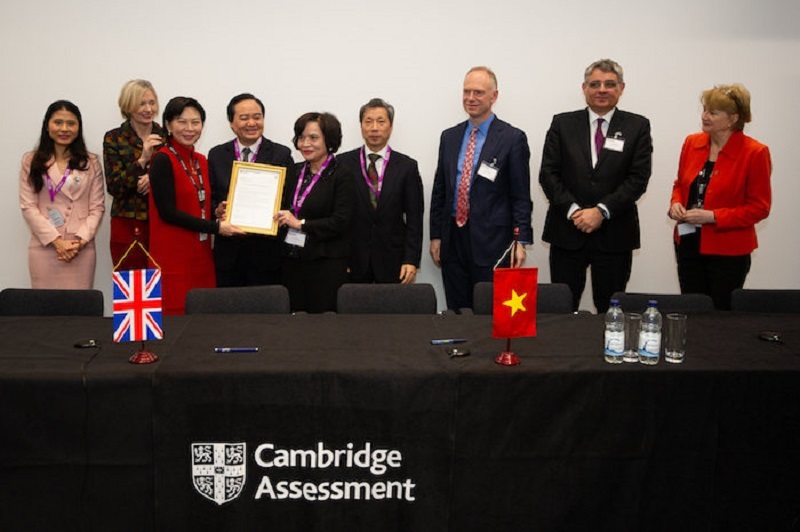Cambridge International Programme and key considerations
- What is the Cambridge International Programme?
- The scale of Cambridge Assessment International Education
- What does the Cambridge curriculum system include?
- Is building a standard Cambridge environment easy to achieve?
- Benefits of the Cambridge Programme
- Challenges & barriers when studying the Cambridge Programme
- How VAS develops the Cambridge International Programme for students
- Conclusion
In a rapidly evolving global landscape, the ability to adapt, innovate, and thrive requires more than just a standard education. Today’s students need a strong foundation that equips them not only with knowledge but also with the critical skills to navigate complexity. This is where the Cambridge International Programme stands out as a comprehensive and future-focused educational pathway.
Adopted by schools in over 160 countries, the Cambridge programme opens doors to world-class learning and internationally recognised qualifications. But what exactly does it entail? Why is it becoming a preferred choice among parents and educators? And what should families consider before enrolling their children in this pathway? Let’s explore these questions in detail.
1. What is the Cambridge International Programme?
The Cambridge International Programme, developed by Cambridge Assessment International Education (CAIE), a department of the prestigious University of Cambridge, offers a structured curriculum designed for students aged 5 to 19. It delivers a rigorous academic framework, with a strong emphasis on core skills such as critical thinking, research, analysis, and communication.
The programme is renowned for its flexible structure, allowing schools to integrate local educational requirements while delivering an international standard of learning. It provides students with a clear and progressive academic pathway, preparing them for higher education, global citizenship, and the demands of the modern workforce.
From the earliest years, Cambridge learners are encouraged to be curious, creative, and confident, traits that are nurtured across subjects and academic levels. Assessments are carried out with integrity and objectivity, recognised and respected by universities and employers worldwide.
Discover the Cambridge International Programme for a global learning journey
2. The scale of Cambridge Assessment International Education
To understand the global impact of the Cambridge International Programme, it's important to look at the reach and reputation of the organisation behind it.
Cambridge Assessment International Education (CAIE) has been delivering international education since 1858, operating under the umbrella of the University of Cambridge, one of the world’s oldest and most esteemed institutions. Today, over 10,000 schools in more than 160 countries offer the Cambridge curriculum.
The scope of CAIE is not limited to providing curriculum frameworks. It also trains educators, supports curriculum integration, oversees rigorous assessment processes, and ensures that all affiliated schools meet strict quality standards. This global network ensures consistency in quality while allowing for cultural adaptation and local relevance.
By enrolling in a Cambridge programme, students gain access to a globally benchmarked education system, supported by a legacy of academic excellence, innovation, and integrity.
3. What does the Cambridge curriculum system include?
To evaluate the Cambridge International Programme effectively, it’s essential to understand what the curriculum offers. Designed to accommodate a wide range of learners across different age groups, the programme ensures academic depth while maintaining flexibility to meet school-specific needs.
3.1. Age groups & applicable levels
The Cambridge curriculum is structured across four educational stages aligned with age and cognitive development:
- Cambridge Primary (ages 5–11)
- Cambridge Lower Secondary (ages 11–14)
- Cambridge Upper Secondary (ages 14–16) – IGCSE
- Cambridge Advanced (ages 16–19) – AS & A Levels
Each stage builds upon the previous one in a spiral progression, reinforcing foundational knowledge while gradually introducing more complex concepts. This ensures learners are not only prepared for the next academic level but also nurtured to grow in confidence and independence.
3.2. Core subjects
The Cambridge curriculum centers on three main subject areas:
- English (as a second language): A strong emphasis is placed on developing all four language skills, listening, speaking, reading, and writing, aligned with CEFR (Common European Framework of Reference for Languages) levels. Assessments are provided through Cambridge English Qualifications such as the PET and FCE.
- Mathematics: Topics are structured around number, algebra, geometry, measurement, and data handling. Lessons encourage logical reasoning, analytical thinking, and real-world application of math skills, developing students' problem-solving abilities from an early stage.
- Science: Encompassing Biology, Chemistry, Physics, and an introductory element called Scientific Enquiry, the science programme promotes experimentation, hypothesis testing, and observation, skills essential for both academic success and real-life inquiry.
In addition to these, the curriculum has been expanded to include Digital Literacy, Art & Design, Music, and Physical Education, ensuring a holistic educational experience that cultivates creativity, digital fluency, and physical well-being.
The Cambridge curriculum in VAS is customized for the intellectual growth of children in the 5–19 age group.
4. Is building a standard Cambridge environment easy to achieve?
Many parents and schools are drawn to the Cambridge label, but establishing a genuine Cambridge-standard learning environment is no small feat.
To become a Cambridge International School, an institution must undergo a comprehensive and rigorous accreditation process administered directly by CAIE. This evaluation assesses:
- Infrastructure quality: including science labs, libraries, classrooms, and IT facilities that must meet international safety and usability standards.
- Teacher qualifications: All educators must meet strict entry criteria and participate in ongoing professional development provided or endorsed by Cambridge.
- Curriculum delivery standards: Schools must demonstrate the ability to implement and assess the Cambridge curriculum with fidelity.
Once accredited, schools benefit from direct collaboration with Cambridge, regular curriculum updates, staff training, and the ability to administer official Cambridge exams internally.
Despite these advantages, the process demands significant investment in training, resources, and institutional readiness. Not all schools are prepared to meet these standards, which is why the Cambridge status remains a mark of prestige and trust among the global education community.
VAS is the first school in Vietnam recognized as a partner of Cambridge Assessment International Education
5. Benefits of the Cambridge Programme
Choosing an educational pathway for a child is a major decision, and the Cambridge International Programme continues to be one of the most trusted choices worldwide. Its strengths lie not only in academic rigour but also in the balance it strikes between global competence and local identity.
Let’s explore the key benefits of this globally respected programme:
5.1. Clear learning pathway from foundation to advanced levels
The Cambridge system is intentionally designed to provide a cohesive academic journey from early childhood to university preparation. Students progress through well-defined stages, each with structured learning objectives and assessment milestones.
This long-term academic scaffolding reduces gaps in knowledge, promotes continuous development, and ensures that students are fully prepared for IGCSE, AS, and A Level qualifications, the gold standard for university admissions across the world.
5.2. Holistic development
More than just academic achievement, the Cambridge curriculum is designed to nurture personal attributes and essential life skills. Students learn to work collaboratively, think critically, communicate clearly, and develop resilience, all traits valued in today’s workforce.
Through subjects such as Global Perspectives, students also gain insight into global issues, cultural diversity, and ethical challenges, preparing them to be thoughtful and informed global citizens.
5.3. International qualifications opening further study opportunities
Cambridge qualifications are recognised by over 1,400 universities worldwide, including top-tier institutions in the UK, USA, Australia, Canada, and beyond. The IGCSE and A Level certificates are widely accepted as equivalent to local qualifications, often giving students an edge in competitive admissions processes.
In some countries, A Level scores can even be used to waive university foundation year requirements, allowing students to fast-track their higher education journey.
Cambridge qualifications are recognized by 1,400+ universities worldwide, opening global study opportunities
5.4. Preserving cultural identity while integrating international and national curricula
One unique feature of the Cambridge model, especially in schools like Vietnam Australia International School (VAS), is its integration with the national curriculum. Students benefit from the global quality of the Cambridge education while still engaging with subjects that reinforce their cultural roots and local knowledge.
This hybrid approach not only makes the transition into international programmes smoother but also ensures students remain grounded in their identity, language, and values.
6. Challenges & barriers when studying the Cambridge Programme
Despite its many advantages, the Cambridge pathway is not without its challenges. For families and students considering this programme, it’s important to be aware of potential hurdles to ensure proper planning and support.
6.1. High academic English requirements from the beginning
One of the biggest initial challenges is the language barrier. The curriculum is taught entirely in English, even in early years, requiring students to have, or rapidly develop, strong English proficiency across listening, speaking, reading, and writing.
For non-native speakers, this can be a major adjustment, especially without prior exposure or language support. If not addressed early, it can impact comprehension and performance across subjects.
6.2. Academic pressure at IGCSE / AS & A Level if not properly supported
Cambridge assessments are known for their depth and complexity. Students who enter IGCSE, AS, or A Level unprepared or unsupported may experience high academic stress. The level of critical thinking, independent study, and exam technique required is significantly more demanding than many national programmes.
Therefore, consistent academic counselling, mentoring, and skill development are crucial to ensure students can thrive rather than struggle.
6.3. Related costs: tuition fees, materials, international standard equipment, supplementary expenses
Pursuing an international programme like Cambridge comes with significant financial investment. Beyond tuition fees, there are costs for imported textbooks, lab equipment, exam registration, teacher training, and digital learning platforms.
Parents must consider not only the direct tuition but also the hidden or recurring costs associated with sustaining a high-quality Cambridge education.
6.4. Not every pathway suits all students
Finally, it’s important to recognise that the Cambridge system, while excellent, is not a one-size-fits-all solution. Some students may find the independent, inquiry-based approach less compatible with their learning style. Others may thrive better in alternative systems that emphasise different strengths, such as project-based learning or local cultural integration.
Personalised assessments and consultations are essential before making a long-term commitment to the Cambridge pathway.
7. How VAS develops the Cambridge International Programme for students
Recognising the transformative power of a world-class education, Vietnam Australia International School (VAS) has strategically implemented the Cambridge International Programme across its campuses. The goal is not only to meet the international standards set by CAIE but to deliver an exceptional learning experience tailored for Vietnamese students in a global context.
7.1. Cambridge curriculum system
At VAS, students are offered three learning pathways depending on their goals, abilities, and family preferences:
- CEP (Cambridge English Programme): A blend of the national curriculum (MOET) with Cambridge English courses, focusing on strong bilingual foundations.
- CAP (Cambridge Academic Programme): Combines the national curriculum with selected Cambridge subjects, including English, Maths, and Science, ideal for students aiming to strengthen academic English while following a rigorous programme.
- CAPI (Cambridge Academic Programme International): A full Cambridge-integrated programme, taught primarily in English across all core subjects, with national curriculum components embedded where appropriate.
These options allow students and families to choose the pace and intensity that suits their needs, while still benefiting from Cambridge’s structured academic progression and qualifications.
The Cambridge curriculum at VAS helps children develop comprehensively
7.2. Campus facilities meeting CAIE's rigorous standards
To deliver the Cambridge curriculum effectively, VAS has made significant investments in facilities aligned with CAIE requirements:
- Science laboratories equipped with British-standard safety and experimental tools, ensuring practical subjects are taught through experience and exploration.
- Digital learning infrastructure, including modern IT labs, high-speed internet, and access to Cambridge digital resources.
- Creative and physical development spaces, such as music rooms, art studios, sports facilities, and green playgrounds, which foster holistic student growth.
Each campus is meticulously designed to provide a safe, engaging, and internationally benchmarked learning environment, ensuring that students are fully immersed in the Cambridge learning culture.
The VAS International School boasts one of the most modern and green campuses today
7.3. What are the graduating qualifications at VAS?
Students graduating from the Cambridge pathways at VAS are equipped with a blend of national and international qualifications, empowering them to pursue diverse future paths.
Depending on the chosen pathway, students may obtain:
- Checkpoint certificates after Primary or Lower Secondary (CEP/CAP)
- PET or other Cambridge English certificates
- Cambridge IGCSE (typically after Grade 10 in CAP)
- AS & A Level certificates in CAPI after Grade 12
- IELTS 6.0+ to 6.5+, essential for university entry
- Vietnamese High School Diploma, ensuring eligibility for local institutions
These credentials are globally recognised and permanently valid, offering students the flexibility to pursue higher education in Vietnam or overseas, and standing out in competitive scholarship or university admission processes.
Students have globally acclaimed qualifications and an unlimited number of opportunities after graduating in VAS
>>> Read more: Explore tuition fees by education level at VAS International School
Conclusion
The Cambridge International Programme represents more than just academic prestige, it’s a commitment to quality, global readiness, and lifelong learning. For students in Vietnam, especially those at VAS, the programme offers a balanced and strategic education that merges the best of international and national curricula.
By providing a clear academic trajectory, fostering critical skills, and maintaining cultural identity, the Cambridge path prepares students not only for university, but for success in an interconnected, rapidly changing world.
Whether families are aiming for local excellence or international opportunities, Cambridge at VAS ensures students are confident, competent, and globally competitive citizens of tomorrow.
>>> Read more:
Essential tips for choosing international schools that parents need to know!
List of the 21 best international schools in Ho Chi Minh City that parents should consider






